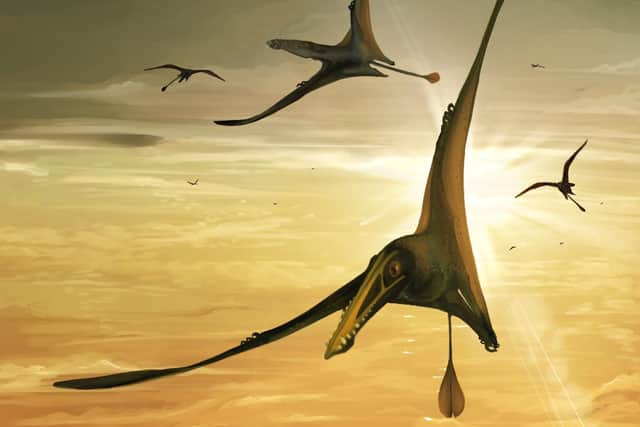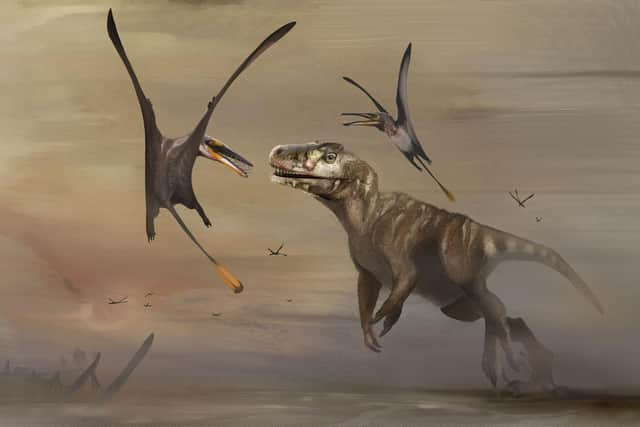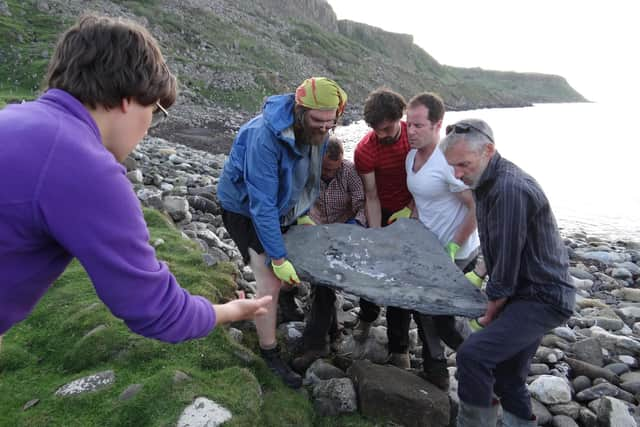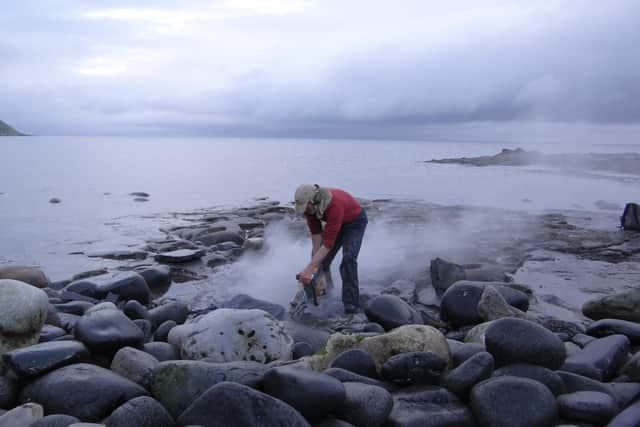World's biggest Jurassic-era pterodactyl discovered on Isle of Skye
A fossilised skeleton of the winged creature, which was around the size of an albatross, is said to be in an “almost pristine condition” despite the pterodactyl dating back around 170 million years.
It was unveiled in the National Museum of Scotland, which has described the discovery as “remarkable” due to how it has been preserved and the new light it sheds on the size of pterosaurs from the Jurassic era, which are now much bigger than previously thought.
Advertisement
Hide AdAdvertisement
Hide AdThe new species of pterosaur, which is said to have had a wingspan of around 2.5 metres, has been given the Gaelic name Dearc sgiathanach, which translates as “winged reptile”.
It was found on a stretch of rocky coastline at Brother’s Point, also known as Rubha nam Brathairean, the dramatic headland on Skye’s Trotternish peninsula where fossilised dinosaur footprints made around 170 million years ago have been discovered.
The creature – discovered during a National Geographic-funded expedition on Skye – is believed to be the biggest animal that had ever flown in this era.
It is the latest in a series of significant palaeontological finds in recent years on what has become known as “Scotland’s Jurassic island”.
The newly-revealed discovery was made in 2017 by PHD student Amelia Penny on a field trip led by Professor Steve Brusatte, a leading palaeontologist at Edinburgh University, one of a team of Scottish scientists behind the ‘Dearc’ research.


They have hailed the “unique specimen” as the best-preserved skeleton of a pterosaur – the world’s first flying animals, which appeared on Earth around 50 million years before birds.
Ms Penny, a field assistant on the expedition, spotted a fossilised jaw protruding from a tidal platform on the rocky beach. After the head of the pterosaur was identified, a team led by Dugald Ross, founder of the nearby Staffin Museum, carried out a painstaking operation, using diamond-tipped saws, to extract the fossil.
Advertisement
Hide AdAdvertisement
Hide AdShe said: “I was just finishing my PhD on a completely unrelated group of fossils. I volunteered to go on the expedition to help with practical stuff in the field and as an extra pair of eyes looking for fossils.
“We were at a site were dinosaur tracks have been discovered in the past. There was a bit of lull in the work when I happened to be standing on a platform of rock where the tide had gone down.


“I glanced down between these mossy boulders and saw a trace of black object on the surface of the rock that was a bit different to anything I’d seen before. It just looked strange to me, but I could make sense of a skull with a row of teeth. I called everyone over to have a look and they were very excited.
“I’ve been getting emails over the last five years with what has been discovered. I still have a slight feeling of disbelief that I found something so special. It’s been such a thrill.”
Professor Brusatte, who was working in a different part of the islands when the discovery was made, said: “When I went to see in the next morning, I could see the entire skull was actually visible.
“We were breaking some of the rocks and starting to remove it as the tide was coming in when we realised that there were other bones there and the head was leading to a skeleton. We had an animal the size of an albatross.


“We couldn’t get it out in time and there were tears as we thought we might have lost some of the bones because they’re so fragile.
Advertisement
Hide AdAdvertisement
Hide Ad“We came back with flashlights and headlamps for the next low tide at midnight. As the water moved away we could see the bones were still there. There was a huge sigh of relief.”
Prof Brusatte has been advising on the new Jurassic World blockbuster, working with director Colin Trevorrow and designers working on the film.
He said: “Skye is really the only place in Scotland where evidence has been found of dinosaurs and Jurassic fossils, going back to the 1970s.
“We’ve been taking students there since I started working at Edinburgh University in 2013 and have found quite a bit there over the last decade.
“The really important thing about Skye is that it’s really one of the only places in the entire world where it's possible to find good fossils from the middle of the Jurassic period. It's a really rare window into that time.


“This pterodactyl is the first record of this group of animals, but it also really big. This thing the size of an albatross, which is much bigger than anybody used to think pterosaurs got during the middle Jurassic period anywhere in the world.
“It’s a largely complete skeleton which is beautifully-preserved, with its bones so pristine, and it is unlike anything ever found in Scotland before. It’s a piece of Scottish heritage which is totally new. It really is a one-in-a-billion discovery.”
Advertisement
Hide AdAdvertisement
Hide AdNatalia Jagielska, one of the researchers aiming to find out more about the Dearc’s behaviour, said: “To achieve flight, pterosaurs had hollow bones with thin bone walls, making their remains incredibly fragile and unfit to preserving for millions of years.
“And yet our skeleton remains in almost pristine condition, articulated and almost complete, its sharp fish-snatching teeth still retaining a shiny enamel cover as if he were alive mere weeks ago."
Dr Nick Fraser, keeper of natural sciences at the National Museum, said: “Even in the context of the amazing palaeontological finds on Skye in recent years, this one really is remarkable.
“To find and describe a specimen which is both so well-preserved and so significant is really special and we’re delighted to add Dearc into our collection. It's a specimen which will be studied now and long into the future.”
Comments
Want to join the conversation? Please or to comment on this article.
